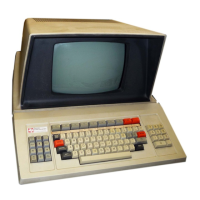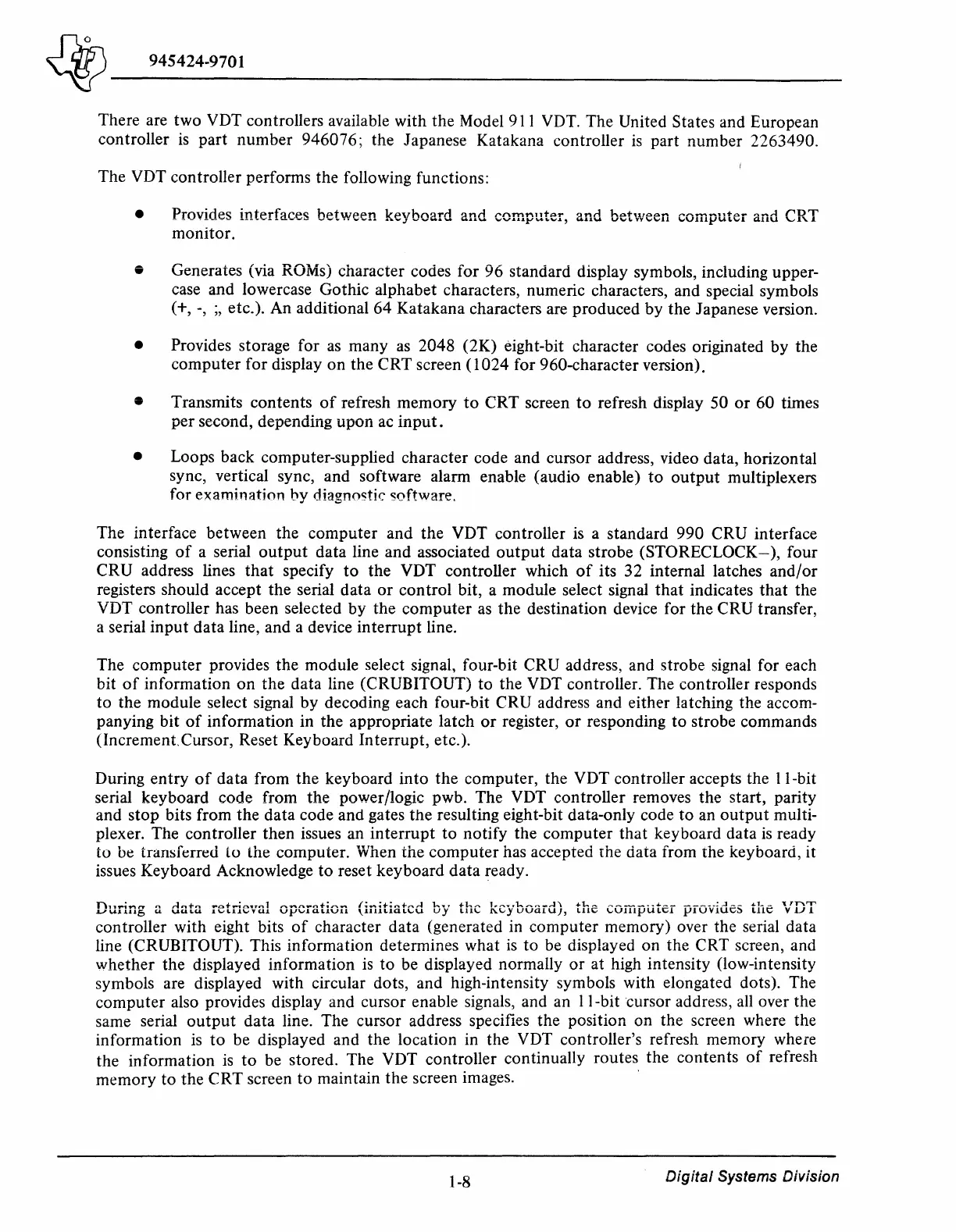~-------
~
945424-9701
There are two VDT controllers available with the Model 911 VDT. The United States and European
controller
is
part
number
946076;
the Japanese Katakana controller
is
part number 2263490.
The VDT controller performs the following functions:
•
Provides interfaces between keyboard and computer,
monitor.
<::1nr1
haturoon
U.J.1.U
V'-"L
YY\..1\..111
• Generates (via ROMs) character codes for
96
standard display symbols, including upper-
case and lowercase Gothic alphabet characters, numeric characters, and special symbols
(+, -,
;,
etc.). An additional
64
Katakana characters are produced by the Japanese version.
• Provides storage for
as
many
as
2048 (2K) eight-bit character codes originated
by
the
computer
for
display
on
the
CRT
screen
(1024
for 960-character version).
• Transmits contents
of
refresh
memory
to
CRT
screen
to
refresh display 50
or
60
times
per
second, depending
upon
ac
input.
• Loops back computer-supplied character code and cursor address, video data, horizontal
sync, vertical sync, and software alarm enable (audio enable)
to
output
multiplexers
for
examination
by
diagnostic software.
The interface between
the
computer
and
the
VDT controller is a standard
990
CRU interface
consisting
of
a serial
output
data
line and associated
output
data strobe (STORECLOCK-), four
CRU
address lines
that
specify
to
the
VDT controller which
of
its 32 internal latches
and/or
registers should accept the serial
data
or
control bit, a module select signal
that
indicates
that
the
VDT controller has been selected
by
the
computer
as the destination device for the CRU transfer,
a serial
input
data
line, and a device
interrupt
line.
The
computer
provides
the
module select signal, four-bit CRU address, and strobe signal for each
bit
of
information
on
the
data line (CRUBITOUT)
to
the VDT controller. The controller responds
to
the module select signal
by
decoding each four-bit CRU address and either latching the accom-
panying bit
of
information in the appropriate latch
or
register,
or
responding
to
strobe commands
(Increment. Cursor, Reset Keyboard Interrupt, etc.).
During
entry
of
data
from
the
keyboard
into
the
computer, the VDT controller accepts the 11-bit
serial keyboard code from the power/logic pwb. The VDT controller removes the start, parity
and
stop
bits from the data code and gates
the
resulting eight-bit data-only code
to
an
output
multi-
plexer. The controller
then
issues an
interrupt
to
notify the
computer
that
keyboard data
is
ready
to
be transferred
lo
the computer. When
ihe
computer
has accepted the data from the keyboard,
it
issues Keyboard Acknowledge
to
reset keyboard
data
ready.
T\n....;.,...rr "
An+n
..,.a+.....:o,rnl "~r. ...
n+;"_
f~-;+~n.4-....,..,.l
\...,..,.
+l.,,..,
1,..,..,,..,.t...._...__,..J\
+t...
......
,.-,.---··•---
----w.!
...l
~-
+1-
-
'l
TT"\.T
.LJ'U.l.1115
u
UULU
11.-L.l.ll.-VU.l
vp1.-.1auv11
\.llUL.lQl.\,,U
uy
I.Ill..
J\..'-'Y
uvaIUJ,
Lllt;;
"-VHljJULt;;I
jJlUVlU\;~
Lllt;;
v
LJ
1
controller with eight bits
of
character data (generated in
computer
memory) over the serial data
line (CRUBITOUT). This information determines what
is
to
be displayed
on
the CRT screen, and
whether
the displayed information
is
to
be displayed normally
or
at high intensity (low-intensity
symbols are displayed with circular dots, and high-intensity symbols with elongated dots). The
computer
also provides display and cursor enable signals, and an 11-bit ·cursor address, all over the
same serial
output
data line. The cursor address specifies the position
on
the screen where the
information
is
to
be displayed and the location in the VDT controller's refresh memory where
the information
is
to
be stored. The VDT controller continually routes
the
contents
of
refresh
memory
to
the
CRT
screen
to
maintain the screen images.
1-8
Digital
Systems Division

